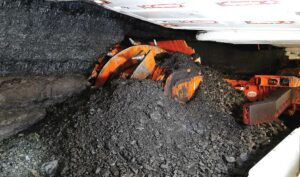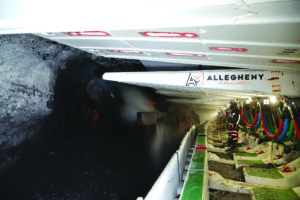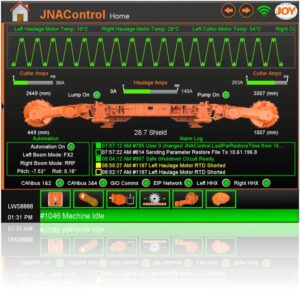
A shearer loads coal at America’s newest longwall installation, the Longview mine in West Virginia. (Photo: Allegheny Metallurgical)
More U.S. longwall operators embrace automation technology to improve horizon control
By Steve Fiscor, Editor-in-Chief
America’s longwall mines produced 133.1 million tons in 2023, which was down 3.1% from 137.3 million tons in 2022. Much of the decrease can be attributed to the loss of production from two mines that are no longer operating. While the official numbers haven’t been tabulated yet, total U.S. coal production will likely be 585.5 million tons for 2023, a 2.1% drop over 2022. U.S. longwall production represents 22.7% of total coal production last year.
One new longwall started production in 2023, another officially ceased operations, and a new longwall is currently being installed. Century Mining LLC, operating as Allegheny Metallurgical, started its new longwall at the Longview mine in West Virginia during December. American Consolidated Natural Resources (ACNR) announced that it would idle its Emery County (Lila Canyon) mine in Utah indefinitely. Coronado Global Resources will start a second longwall at the Buchanan mine in Virginia later this year. The number of faces increased from 36 to 37, while the number of operators remained the same (32). Those numbers include two trona mines in Wyoming and five mines that will operate two longwall faces in 2024.
Last year, ACNR’s longwall mines produced 46.8 million tons, followed by CONSOL Energy (26 million tons), Alliance Resource Partners (14.1 million tons) and Arch Resources (8.6 million tons). CONSOL Energy’s Bailey Complex in Pennsylvania remains the leading longwall complex with nearly 11.2 million tons in 2023, followed by CONSOL Energy’s Enlow Fork Complex (8.7 million tons) in Pennsylvania, and Alliance Resource Partner’s Tunnel Ridge mine (7.7 million tons) in West Virginia. Tunnel Ridge produces coal from a single face, while Bailey and Enlow Fork both operate two faces. A total of 14 longwall mines produced more than 5 million tons in 2023 (see Table 2).
CONSOL Energy operates five longwall faces in the Pittsburgh No. 8 seam in southwestern Pennsylvania. The company’s Harvey mine set a new production record in 2023 of 6,237,282 tons. The Harvey mine’s production has grown steadily from 4.4 million tons in 2020. The Bailey Complex has produced more than 11 million tons in the last three years. Enlow Fork’s 8.7 million tons is also notable as the mine averaged 6.3 million tons in the previous three years.
Signal Peak’s Bull Mountains mine in Montana produced nearly 7.6 million tons in 2023. The mine operates one longwall, but it owns two faces. Last year, 159 new ZMJ shields were delivered to the mine. Signal Peak has ordered an additional 50 ZMJ shields — to be delivered in 2024 — that will complete the set.
Coronado Global Resources continues to advance its Buchanan expansion project to handle the increased production it expects from its longwall mining systems. In Q4 2023, longwall development was completed in the new South District of the mine, which will allow the Buchanan mine to operate an additional underground district with new equipment and allow for more operational flexibility for mining from both the North and South areas of the mine.
 The company also reported that Buchanan’s production was impacted by poor geotechnical conditions, resulting in a 10-day production outage in December to secure additional roof support. Normal longwall operating conditions have resumed, but the event deferred roughly 132,000 tons of production. Prior to these events, Buchanan’s operational performance was exceeding production forecasts.
The company also reported that Buchanan’s production was impacted by poor geotechnical conditions, resulting in a 10-day production outage in December to secure additional roof support. Normal longwall operating conditions have resumed, but the event deferred roughly 132,000 tons of production. Prior to these events, Buchanan’s operational performance was exceeding production forecasts.
Under a cooperative agreement between Komatsu, Becker-Warkop and Hydrotech, 385 new longwall powered roof supports were delivered to Warrior Met in Alabama (See Suppliers News, p. 38). The first face began operation in July 2023 and the second face is undergoing installation. While Komatsu has provided shields to Warrior Met in the past, this is the first set of roof supports supplied in collaboration with Becker-Warkop and Hydrotech.
Industry Demographics
Longwall ownership in the U.S. remained relatively unchanged. ACNR and the companies it controls (Foresight Energy and Hatfield Metallurgical) operate 11 longwall faces spread across Alabama (1), Illinois (4), Utah (1) and West Virginia (5). CONSOL Energy operates three mines with five longwall faces in Pennsylvania. Alliance Resource Partners, Arch Resources and Warrior Met Coal own three longwall faces.
With 10 faces, West Virginia remains the longwall leader, followed by Pennsylvania (6), Illinois (5) and Alabama (5).
 Looking at the numbers, the average U.S. longwall mine operating in coal produced 4.75 million tons in 2023 compared to 4.70 million tons in 2022. On average, it has a cutting height of 94.8 in., a panel width (or face length) of 1,243.1 ft, and a panel length of 12,625.7 ft. Last year, those numbers were 95.5 in., a panel width (or face length) of 1,234.6 ft, and a panel length of 13,144.6 ft, respectively. A total of six longwall faces have face lengths of 1,500 ft or greater. A total of 11 longwalls operate in the Pittsburgh No. 8 seam. The maximum overburden on average reaches 1,148.1 ft. Except for a few mines in Utah, most are developed with 3-entry gates. Using an double-drum, ranging-arm shearer with a total power of 1,861-hp, they take a 40.6-in. cut. The average yield setting on the shields is 1,072.1 tons. All the faces except for three are high voltage (4,160 volts).
Looking at the numbers, the average U.S. longwall mine operating in coal produced 4.75 million tons in 2023 compared to 4.70 million tons in 2022. On average, it has a cutting height of 94.8 in., a panel width (or face length) of 1,243.1 ft, and a panel length of 12,625.7 ft. Last year, those numbers were 95.5 in., a panel width (or face length) of 1,234.6 ft, and a panel length of 13,144.6 ft, respectively. A total of six longwall faces have face lengths of 1,500 ft or greater. A total of 11 longwalls operate in the Pittsburgh No. 8 seam. The maximum overburden on average reaches 1,148.1 ft. Except for a few mines in Utah, most are developed with 3-entry gates. Using an double-drum, ranging-arm shearer with a total power of 1,861-hp, they take a 40.6-in. cut. The average yield setting on the shields is 1,072.1 tons. All the faces except for three are high voltage (4,160 volts).
Iron Senergy’s Cumberland mine operates the longest face at 1,580 ft. Coronado’s Buchanan mine and ACNR’s Emery County mine are the deepest at 2,000 ft, and 2,200 ft respectively. At 26,000 ft, Foresight Energy’s Mach No. 1 mine has the longest panel.
 Allegheny Met Starts Its Longwall
Allegheny Met Starts Its Longwall
The longwall at Allegheny Metallurgical’ s Longview mine began cutting coal on December 8, 2023. The entire commissioning process including the longwall start-up went well, explained Ryan Toler, general manager for the Longview mine. “Everything went as planned and we started mining just after midnight,” Toler said.
One of the advantages of building a new mine, as opposed to moving from one panel to the next, is that the miners at Allegheny Met had time to test the equipment before they staged it for set-up underground. During 2023, two development sections were driving the tailgate and the headgate for the first panel. Once the start line was established between those two headings, they began to build the longwall. They set the first piece of panline on November 10.
Prior to the installation, the longwall team participated in some pre-commissioning exercises on the surface. They assembled a mini build. “We basically set the entire system up in the yard along with 25 shields,” Toler said. “We brought everything online as if it were operating underground, including the electrics, the pump cars, the head drive, tail drive, shearer, etc., and performed compatibility testing and trained miners.” Toler said they made modifications on a few small items, but everything worked well.
The miners broke the system down and began transporting it underground. “We transported and stored all the shields and panline on the tailgate section prior to the completion of development,” Toler said.
The miners that were transporting and building the longwall were a mix of experienced and inexperienced hands. “We hired folks without longwall experience, and we trained them,” Toler said. “We had the luxury of assembling and disassembling that mini build and they participated in that before helping set it up underground. It was a positive experience.”
Allegheny Met has an experienced longwall management team. “All the face foremen are experienced longwall supervisors,” Toler said.
The Longview longwall has full automation capabilities. “We are not using the full automation features yet, but the shields advance automatically,” Toler said.
The mine currently runs 24/7 with two 12-hour shifts per day. The current panel is expected to last until July. “Development is running as expected,” Toler said. “We run two development sections, and our next gate development has advanced halfway for the next panel.” When it comes time to move the longwall, Allegheny Met has a spare panline and a spare shearer like most longwall mines in the U.S.
The Longview mine was designed as a longwall mine. The conveyor system has the capacity to clear the coal from the face as fast as the shearer can cut it. “We are running a 72-in. conveyor on the mainline and it has the capacity to carry 5,700 tons an hour,” Toler said.
As this edition was going to press, the Longview longwall had retreated about 1,000 ft through its first panel.

The shearer makes its first pass at the Longview mine on December 8, 2023. (Photo: Allegheny Metallurgical)
Komatsu Advances Shearer Automation Technology
Over the last year, Komatsu has installed six new Landmark face alignment systems on U.S. longwall faces, and they have five more in the works, which will likely come online later this year. “That’s a big leap for a relatively small group of mines from an automation standpoint,” said Jeff Ley, control and automation manager for the Americas for Komatsu. Ley manages a team that installs longwall automation features and trains miners how to use the software.
“All of the longwalls operated by American Consolidated Natural Resources have been upgraded from memory cut to advanced shearer automation,” Ley said. “They are really taking advantage of technology. They are consistently operating with automated roof and floor cuts from the tailgate to the main gate.”
This year, Komatsu will also introduce the Faceboss 2.0 control system for shearers. “We already have a couple of shearers scheduled for upgrade,” Ley said. “The Faceboss 2.0 system is a technology jump as far as processing power, memory storage, and system architecture with improved diagnostics. We have added web-based, human machine interface (HMI) screens that allow the user to access the shearer HMI screens from anywhere on the longwall network.”
Compared to the original Faceboss system, Faceboss 2.0 has a few new pieces of hardware. The layout of the IO modules and the sensors have been changed to improve diagnostics and reliability, Ley explained. “The HMI is very, very different,” he said. “The previous system used an off-the-shelf product for its HMI. The HMI for Faceboss 2.0 control system was developed by us in-house here [in the Pittsburgh area], so there are no dongles or licenses to pay for.”
When it comes to longwall automation, the previous control system had reached its capacity. The new Faceboss 2.0 control system can be installed during a rebuild and it will enable longwall operators to use more automation features, explained Shawn Franklin, production manager-longwall shearers for Komatsu. “When you consider the overall cost of a shearer rebuild, the cost of the technology upgrade is almost negligible,” he said. “It’s just something that we plan to do at rebuild, and then of course the training that comes along with it will be a vital aspect of it as well.”
As longwall mining moves toward autonomous operation, the Faceboss 2.0 system provides the building blocks to establish remote management from the surface.
Safety is a primary driver and autonomous operations remove operators from the face,” Franklin said. “We also have a lack of skilled operators these days. Some mines are embracing this technology to compensate for that.”
“Our goal is to give an operator on the surface the tools to plan the cutting sequence instead of just reacting live to what’s happening underground,” Ley said. “We want to be able to tell the shearer and the roof supports what to do ahead of time instead of reacting to seam changes in real time. We are focused on the equipment and technology that can get us to that point.”

The new Faceboss 2.0 system will provide more automation features. (Photo: Komatsu)
If the engineers know that the seam narrows in a certain zone or that the longwall will encounter pitches and rolls as it retreats through the panel, then they can program that into the system. “Today, an operator has to manually steer the cutting drums to account for these variations in the seam,” Ley said. “Our goal is to get to a point where the system does that automatically.”
Looking toward the future, Komatsu will be introducing a new control system (RS20N) for roof supports and armored face conveyors (AFCs) in the next year or two. The company will also display a new ranging arm at MINExpo later this year.
The RS 20N will replace the RS 20S and the N stands for network. “What the RS 20N brings to the table is a high speed one gigabit per second backbone along the roof supports,” Ley said. “Once we have that high-speed communication link, that opens up the window for us to stream live video, connect to smart sensors and other emerging technologies that will bring us closer to the fully autonomous shearer.” Ley estimates that the RS 20N will provide approximately 10 times more bandwidth than any other systems offered today.
The RS 20N can also be extended onto the AFC. “We are introducing a new AFC control system that uses a lot of the same hardware used for the roof support control system,” Ley said. “Longwall operators can share hardware between the two. It’s a completely intrinsically safe system with plug-and-play hardware and sensors. Because it’s intrinsically safe, the cabling does not have to pass through bulky, expensive explosion-proof enclosures, which also reduces the footprint.”
Komatsu will unveil a new prototype ranging arm, the J7500, at MINExpo. “At MINExpo 2021, we had had a 3D model we were discussing with longwall operators,” Franklin said. “It was still conceptual then, but we will be building the J7500 soon and testing it.”
Komatsu has been working with the National Institute for Occupational Safety and Health (NIOSH) on a seam detection project. In 2021, NIOSH awarded Komatsu with a contract to develop technologies and sensors that could be used to detect the coal-rock interface. “We have been evaluating ways to detect the seam with various sensors, vibration, audio, advanced imaging, etc., which would ultimately improve horizon control,” Franklin said. “We collected data from the Leer mine, and we have some encouraging results. We are confident that we can detect the coal-rock interface using advanced analytics. We will be wrapping that project up later this year and NIOSH will publish the report.”






